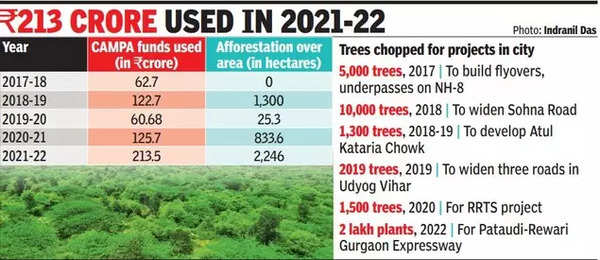[ad_1]

This is because the state has not received a nod from the Union environment ministry, which pointed out several lapses in its proposal for compensatory afforestation. Details of plantation drives carried out previously and Compensatory Afforestation Fund Management and Planning Authority (CAMPA) funds used up since 2019 are among the information sought by the ministry.
Compensatory afforestation refers to planting of trees to make up for the loss of green cover as land is diverted for infrastructure projects such as construction of roads. Every year, CA activities such as plantation drives are carried out from June to August, when the rainy season improves the success rate for saplings to grow and survive.
First, the state was late in sending its CAMPA proposals to the Union ministry. The proposal – which sought approval to plant saplings on 1,197 hectares of land for Rs 111 crore – was sent on May 15, though usually, this should happen in March.
The environment ministry wrote back to the state on July 17 with several objections. In the letter signed by national CAMPA’s chief executive officer Subhash Chandra, the state was asked to give details about funds it has collected from 2019 to 2023, the amount it has utilised, and the balance it is left with.
“The reconciled report on the forest land diverted and the compensatory afforestation (CA) raised, amount realised from user agencies and balance amount available with the state government/authority for carrying out CA and other mandatory activities is to be furnished along with status of funds available for meeting the aforementioned activities,” the letter, a copy of which is with TOI, stated.
The ministry of environment, forest and climate change (MOEFCC) also asked for the status of plantation drives for CA carried out in the years before.
Haryana’s forest cover – 3.9% of the state’s total area – has been stagnant for two decades. In 2005, the state’s forest cover was 1,604sqkm and in 2021, it was 1,603sqkm, according to the Forest Survey of India (FSI).
At the same time, urban areas such as Gurgaon and Faridabad have rapidly grown to make space for houses, businesses, roads and other infrastructure. For instance, 5,000 trees were felled to make way for flyovers and underpasses on NH-8 in Gurgaon in 2017, and a year later, permission was granted to chop 10,000 trees to widen Sohna road.
“The observations were made after scrutiny of Haryana’s CAMPA proposal. The proposal has several discrepancies. As a result, the state was asked to submit more details,” a senior environment ministry official told TOI.
The government also needs to clarify why its own proposal to the ministry goes over and above the cap of 25% of net present value (NPV) funds – a limit decided by the state’s own executive committee for compensatory afforestation in a meeting earlier this February.
An NPV fund is the amount collected by the state from agencies that get permission to cut trees and plants for an infrastructure project. This fund is supposed to be used for CA, but the entire amount cannot be used up all at once as the success of a plantation drive isn’t guaranteed, according to norms. In the proposal, the Haryana government has sought to use up Rs 88.6 crore – or 33% – of its NPV fund of Rs 264.9 crore this financial year.
Asked about the objections, CAMPA Haryana chairperson Pankaj Goyal told TOI state officials will meet officials of the ministry to get clarity. “We have a meeting on August 31 regarding the same. We are hoping to get approval,” he said.
On the delay, Goyal said, “All measures are being taken. We are on track.”
As of April 1, Haryana had Rs 1,049 crore collected in CAMPA funds accumulated since the early 2000s. Last financial year, the state had targeted planting saplings on 2,306 hectares of land. Of this, it managed to carry out plantations on 1,608 hectares.
[ad_2]
Source link

